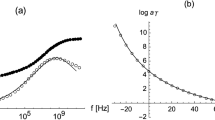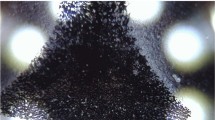Abstract
Friction of solids involves short-range forces between adjacent surface layers, which are largely determined by the shape and structure of those layers, which are themselves determined to a considerable extent by the relative velocity. A theory of friction thus involves the microstructure and the detailed physical phenomena near the surfaces.
However, most existing theories are based on phenomenological (essentially macroscopic) concepts (see [1] for a survey), though the explicit use of microscopic concepts is presented in [2], where it is shown that one elastic body sliding over another gives rise to elastic waves that carry energy away from the contact surface. This loss may be treated formally as due to a tangential force resisting the motion. The force defined in this way has a falling velocity characteristic.
There is much evidence that the friction differs greatly from that for ordinary elastic bodies if one body (or both) should be highly elastic (rubber, polymer, etc) [3]. A model describing these differences would be of considerable interest.
Here we consider the somewhat idealized ease of a rubbery body sliding over a crystalline one; the frictional force is deduced as a function of the velocity and other parameters. The surfaces are taken as smooth and clean, while the bodies are homogeneous. Various simplifying assumptions are made, but these are unimportant from the qualitative standpoint.
Similar content being viewed by others
References
A. S. Akhmatov, Molecular Physics of Boundary Friction [in Russian], Fizmatgiz, 1963.
E. Adirovich and D. Blokhinzev, On the Forces of Dry Friction, J. Phys. USSR, vol. 7, no. 1, p. 23, 1943.
F. S. Conant and J. W. Liska, Friction Studies on Rubberlike Materials. RubberChem. andTechnol., vol. 133, no. 5, p. 1218, 1960.
E. M. Lifschitz, “Theory of the molecular forces of attraction between condensed bodies, ” DAN SSSR, vol. 97, no. 4, p. 643, 1954.
B. V. Deryagin and I. I. Abrikosova, “Direct measurement of the molecular attraction between solids under vacuum, ” DAN SSSR, vol. 108, no. 2, p. 214, 1956.
Author information
Authors and Affiliations
Additional information
We are indebted to G. I. Barenblatt for a discussion.
Rights and permissions
About this article
Cite this article
Buevich, Y.A., Leonov, A.I. Theory of dry friction of rubbery materials. J Appl Mech Tech Phys 6, 50–53 (1965). https://doi.org/10.1007/BF00919312
Issue Date:
DOI: https://doi.org/10.1007/BF00919312




